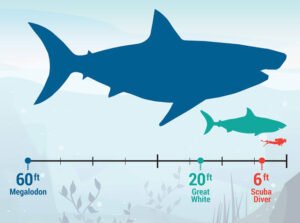The megalodon shark is a prehistoric animal that lived in the ocean. They are one of the largest ocean animals. They lived almost 23 to 3.6 million years ago. And they became extinct at the end of the Pliocene, 2,6 million years ago. The megalodon shark resembles the modern great white shark, as both share many similarities. However, modern research suggests that they are closely related to the ancestor of the Mako shark. Modern research indicates that megalodon was the largest version of the great white shark, based on tooth similarities. A recent study shows the megalodon may have been longer and more slender than previously thought.

Size
The Megalodon shark (Otodus Megalodon) is one of the most powerful predators in Earth’s history.
Length
- Many people and researchers suggest the length of the megalodon is about 13 to 18 meters (43 to 59 feet).
- Some scientists and researchers estimate it goes up to 20 to 25 meters (66 to 82 feet), but these are just theories.

Weight
- The weight is around 50 to 70 tons.
- Some are very large; it’s a weight estimate of up to 100 tons.
General Bodt Width
- The body width is about 3 to 4.5 meters (10 to 15 feet) across the body, its head, or mid-body.
- Some are very big, their width estimated to be up to 5 meters.
Tail
- The tail is about 3.5 to 4.5 meters (11 to 15 feet) tip tip tip for powerful propulsion.
Fin size
- Dorsal Fin Size(Top fin): The megalodon dorsal fin height was around 1.6 to 2 meters (5.2 to 6.6 feet tall. These heights of an average adult human.
- Pectoral Fins(Side Fins): The length of pectoral fins is around 3 meters (10 feet). These fins are long and broad, helping support its massive size and turning ability.

- Caudal Fin(Tail fin): The megalodon width, tip to tip around 3.5 to 4.5 meters (11 to 15 feet). It is a curved, elongated shape like a great white shark giving giving strong swimming power.
All of these records its just research and fossils, examining information, no confirmed idea of the megalodon shark’s size. This information is based on scientific research and fossil discoveries.


